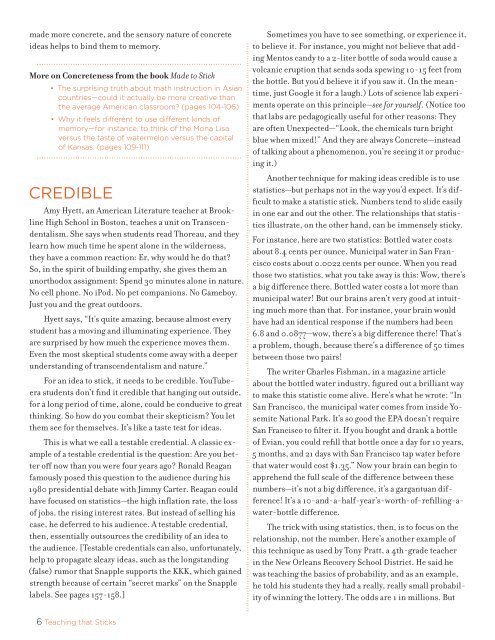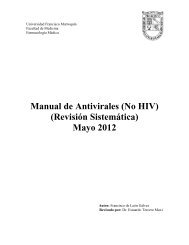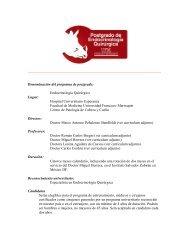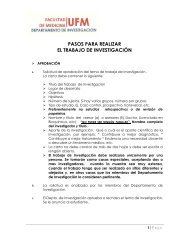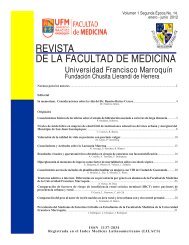Teaching That Sticks (pdf)
Teaching That Sticks (pdf)
Teaching That Sticks (pdf)
- No tags were found...
You also want an ePaper? Increase the reach of your titles
YUMPU automatically turns print PDFs into web optimized ePapers that Google loves.
made more concrete, and the sensory nature of concrete<br />
ideas helps to bind them to memory.<br />
More on Concreteness from the book Made to Stick<br />
• The surprising truth about math instruction in Asian<br />
countries—could it actually be more creative than<br />
the average American classroom? (pages 104-106)<br />
• Why it feels different to use different kinds of<br />
memory—for instance, to think of the Mona Lisa<br />
versus the taste of watermelon versus the capital<br />
of Kansas. (pages 109-111)<br />
CREDIBLE<br />
Amy Hyett, an American Literature teacher at Brookline<br />
High School in Boston, teaches a unit on Transcendentalism.<br />
She says when students read Thoreau, and they<br />
learn how much time he spent alone in the wilderness,<br />
they have a common reaction: Er, why would he do that?<br />
So, in the spirit of building empathy, she gives them an<br />
unorthodox assignment: Spend 30 minutes alone in nature.<br />
No cell phone. No iPod. No pet companions. No Gameboy.<br />
Just you and the great outdoors.<br />
Hyett says, “It’s quite amazing, because almost every<br />
student has a moving and illuminating experience. They<br />
are surprised by how much the experience moves them.<br />
Even the most skeptical students come away with a deeper<br />
understanding of transcendentalism and nature.”<br />
For an idea to stick, it needs to be credible. YouTubeera<br />
students don’t find it credible that hanging out outside,<br />
for a long period of time, alone, could be conducive to great<br />
thinking. So how do you combat their skepticism? You let<br />
them see for themselves. It’s like a taste test for ideas.<br />
This is what we call a testable credential. A classic example<br />
of a testable credential is the question: Are you better<br />
off now than you were four years ago? Ronald Reagan<br />
famously posed this question to the audience during his<br />
1980 presidential debate with Jimmy Carter. Reagan could<br />
have focused on statistics—the high inflation rate, the loss<br />
of jobs, the rising interest rates. But instead of selling his<br />
case, he deferred to his audience. A testable credential,<br />
then, essentially outsources the credibility of an idea to<br />
the audience. [Testable credentials can also, unfortunately,<br />
help to propagate sleazy ideas, such as the longstanding<br />
(false) rumor that Snapple supports the KKK, which gained<br />
strength because of certain “secret marks” on the Snapple<br />
labels. See pages 157-158.]<br />
Sometimes you have to see something, or experience it,<br />
to believe it. For instance, you might not believe that adding<br />
Mentos candy to a 2-liter bottle of soda would cause a<br />
volcanic eruption that sends soda spewing 10-15 feet from<br />
the bottle. But you’d believe it if you saw it. (In the meantime,<br />
just Google it for a laugh.) Lots of science lab experiments<br />
operate on this principle—see for yourself. (Notice too<br />
that labs are pedagogically useful for other reasons: They<br />
are often Unexpected—“Look, the chemicals turn bright<br />
blue when mixed!” And they are always Concrete—instead<br />
of talking about a phenomenon, you’re seeing it or producing<br />
it.)<br />
Another technique for making ideas credible is to use<br />
statistics—but perhaps not in the way you’d expect. It’s difficult<br />
to make a statistic stick. Numbers tend to slide easily<br />
in one ear and out the other. The relationships that statistics<br />
illustrate, on the other hand, can be immensely sticky.<br />
For instance, here are two statistics: Bottled water costs<br />
about 8.4 cents per ounce. Municipal water in San Francisco<br />
costs about 0.0022 cents per ounce. When you read<br />
those two statistics, what you take away is this: Wow, there’s<br />
a big difference there. Bottled water costs a lot more than<br />
municipal water! But our brains aren’t very good at intuiting<br />
much more than that. For instance, your brain would<br />
have had an identical response if the numbers had been<br />
6.8 and 0.0877—wow, there’s a big difference there! <strong>That</strong>’s<br />
a problem, though, because there’s a difference of 50 times<br />
between those two pairs!<br />
The writer Charles Fishman, in a magazine article<br />
about the bottled water industry, figured out a brilliant way<br />
to make this statistic come alive. Here’s what he wrote: “In<br />
San Francisco, the municipal water comes from inside Yosemite<br />
National Park. It’s so good the EPA doesn’t require<br />
San Francisco to filter it. If you bought and drank a bottle<br />
of Evian, you could refill that bottle once a day for 10 years,<br />
5 months, and 21 days with San Francisco tap water before<br />
that water would cost $1.35.” Now your brain can begin to<br />
apprehend the full scale of the difference between these<br />
numbers—it’s not a big difference, it’s a gargantuan difference!<br />
It’s a 10-and-a-half-year’s-worth-of-refilling-awater-bottle<br />
difference.<br />
The trick with using statistics, then, is to focus on the<br />
relationship, not the number. Here’s another example of<br />
this technique as used by Tony Pratt, a 4th-grade teacher<br />
in the New Orleans Recovery School District. He said he<br />
was teaching the basics of probability, and as an example,<br />
he told his students they had a really, really small probability<br />
of winning the lottery. The odds are 1 in millions. But<br />
6 <strong>Teaching</strong> that <strong>Sticks</strong>


